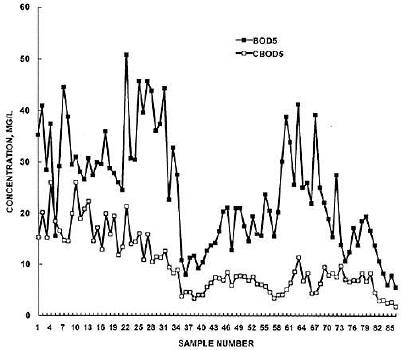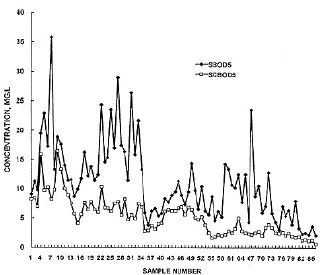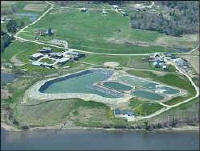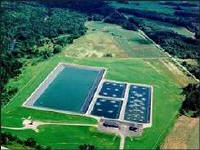AERATED
LAGOON TECHNOLOGY

by
Linvil G. Rich
Alumni Professor Emeritus
Department of Environmental
Engineering and Science
Clemson University -
Clemson, SC 29634-0919 USA
Email: lrich@clemson.edu;
Tel. (864) 656-5575; Fax (864) 656-0672
Technical Number 1
EFFLUENT BOD5
A MISLEADING PARAMETER FOR THE PERFORMANCE
OF AERATED LAGOONS TREATING MUNICIPAL WASTEWATERS
In
spite of the fact that effluent BOD5 is a key parameter in many discharge
permits for aerated lagoons, it is the most misleading. Most effluent
BOD5 data are flawed as the result of being inflated by nitrification
that occurs in the BOD5 test itself. It has been reported that as many as 60
percent of the BOD5 violations nationally may have been caused by nitrification
in the BOD5 test rather than by improper design or operation (Hall and Foxen
1983). Consequently, millions of dollars may have been spent needlessly on new
treatment facilities.
The total BOD of a wastewater is composed of two components – a
carbonaceous oxygen demand and a nitrogenous oxygen demand.
Traditionally, because of the slow growth rates of those organisms that exert
the nitrogenous demand, it has been assumed that no nitrogenous demand is
exerted during the 5-day BOD5 test. Although, such assumption is valid when the
test is performed on untreated municipal wastewaters, it is not valid when
performed on secondary effluents, especially those from aerated lagoons. The
BOD5 of effluents from the latter are almost always inflated by a nitrogenous
component. Moreover, unlike the carbonaceous demand which is proportional to the
concentration of the biodegradable carbon constituents in the effluent, the
nitrogenous demand exerted during the 5-day test is proportional to the number
of nitrifying organisms that happen to be caught in the sample being tested.
Thus the argument that the test provides insight on the impact that the effluent
will have on the receiving water can not be defended. Neither can the practice
of making waste-load allocations from models that contain both a BOD5 (assumed
to be a measure of the carbonaceous demand) and a nitrogenous demand.
The
severity of the problem is illustrated in Figs. 1 and 2. Figure 1 compares the
effluent BOD5 with the CBOD5 (carbonaceous component of the BOD5). The CBOD5 is
determined by using a nitrification suppressant in the BOD5 test. Figure 2
compares the two parameters in filtered samples. Note should taken of the
magnitude of the nitrification factor in the 5-day test. Similar magnitudes are
observed in effluents from aerated lagoons in warmer climates.

Figure 1
click on graph to
enlarge
Figure 1 above illustrates Effluent BOD5 and CBOD5 data from an aerated lagoon
system in Maine that treats a domestic wastewater. (Courtesy of George Bloom,
Woodard and Curran, Engrs. Taken from Rich (1999))

Figure 2
click on graph to
enlarge
Nitrification in the BOD5 test has been thoroughly
researched and documented (Young 1973; Dague 1981; Barth 1981; Carter 1983;
Chapman et al. 1991). Such nitrification can be eliminated by the use of
commercially available nitrification inhibitors, a practice recommended by
Standard Methods (1995). Chapman et al. (1991) demonstrated that by cleaning the
sampler tubing weekly with chlorine bleach, nitrification in the BOD5 test can
be reduced. The U.S. EPA has given their approval to the use of a nitrification
inhibitor, provided that the effluent permit states the limit in terms of the
CBOD5 instead of the BOD5. Arguing that secondary BOD5 limits were initially
established on the basis of values flawed by nitrification, the EPA has
suggested that the CBOD5 limit for secondary treatment be 25 mg/L rather than
the 30 mg/L allowed when the limit is stated in terms of BOD5 (Hall and Foxen
1983). Considering the fact that the nitrification component of the BOD5 is
generally at least 5 mg/L and frequently as high as 50 mg/L, the 25 mg/L limit
appears to impose no handicap.
In summary, BOD5 is an ambiguous parameter when
applied to secondary effluents, especially those of aerated lagoons, and should
not be used. Instead, use should be made of the CBOD5 test which specifically
measures the concentration of the biodegradable carbonaceous materials.
REFERENCES
Barth,
E. F. (1981). “To inhibit or not to inhibit: that is the question.” J. Wat.
Pollut. Control Fed., 53(11), 1651-1652.
Carter,
K. B. (1984). “30/30 hindsight.” J. Wat. Pollut. Control Fed., 56(4), 301-305.
Chapman
et al. (1991). “Minimizing the impact of nitrification in nitrifying
wastewaters.” Operations Forum, WPCF, Sept. 14-16.
Dague,
R. E. (1981). “Inhibition of nitrogenous BOD and treatment plant performance
evaluation.” J. Wat. Pollut. Control Fed., 53(12), 1738-1741.
Hall, J.
C. and Foxen, R. J. (1983). “Nitrification in the BOD test increases POTW
noncompliance.” J. Wat. Pollut. Control Fed., 55(12), 1461-1469.
Rich, L.
G. (1999). High Performance Aerated Lagoon Systems. American Academy of
Environmental Engineers.
Young,
J. C. (1973). “Chemical methods for nitrification control.” J. Wat. Pollut.
Control Fed., 45(4), 637-646.

| 
